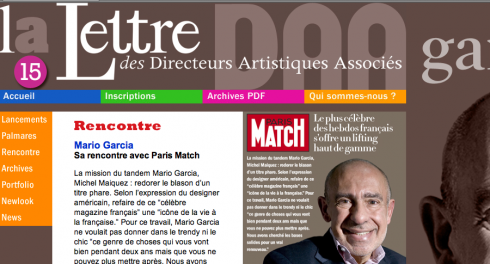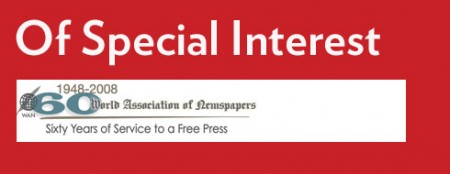
It is not everyday that we sit in an auditorium and hear this kind of music. William Powers, a media columnist for The Nation magazine gave a keynote presentation that was brief and to the point, well illustrated, but packed with enough substance to make you leave the room thinking. One could see the happy faces of editors and publishers in the audience.
Here was someone telling them that their printed product would be around forever. A couple around me were text messaging, probably their bosses back home, to tell them: there is hope yet, don’t close the shop and don’t sell that printing press just yet!
However, Powers also outlined some of the keys to an eternal life for print. His love affair with “paper” goes only so far. Print is eternal if newspapers focus their content to cater to an audeince that is highly interested in technology and its role in their lives. Powers believe that newspapers don’t do enough to cover their own story, their role, and the importance of the new technology and how it makes them relevant and necessary.
Cover the technology beat to perfection
“Much of the media coverage of digital technology reads like product
marketing. New digital devices are released, and journalists cover them the
way they cover new movies. There¹s a cheerleading to the whole exercise, an
air of hype,” he said.
“By focusing almost exclusively on what¹s new and hot in the technology
marketplace, we are missing the larger picture. We aren¹t helping people
understand and organise their technological lives. I think this is an area
where the public craves insight and guidance that they¹re not receiving.
It¹s crucial that we all learn to think more intelligently about our
devices. Not just how they work, but how they fit into our lives. We need to
ensure that the devices work for us, rather than us working for them.”
The Newspaper as an Island of Peace
When Powers referred to the printed newspaper as an island of peace in the digital ‘chaos’ I smiled, as I do remember sitting in focus groups of major metropolitan dailies and hear readers actually say that they equate reading in front of a computer as work, but see reading on a printed page as more of a leisure activity. That ‘s a thought.
Powers took it a few steps further, and the audience loved his description of the solace we find reading in print as opposed to the complications that technology may serve us reading online:
“When you¹re reading an article on a screen, your mind is conscious of all
the other information that¹s just a click away from your inbox to the
latest headlines to your bank account to a billion You Tube videos. Thus,
instead of escaping other demands on your attention as you read, you are
mentally fending off those demands every moment you¹re at the screen.”
“The world needs desperately needs what newspapers do,“said Powers, who is author of Hamlet¹s Blackberry, an essay on the enduring power of
paper, and who plans to write a book on the subject.
“Digital media have well-known advantages,” he said. ” but many people often overlook the
things that print does better, he said. Newspapers would do well to exploit
these qualitative advantages. Among other things, paper frees up the brain
to think.”
“Paper¹s great strength is that it allows the mind to settle down into
that peaceful deep-dive state in which we do our best thinking. This state
is much harder to achieve when we¹re reading in the digital medium, where
there is endless information, and so many possible tasks to undertake at
any moment. On the internet, there is no beginning and no end.”
Can there ever be too much information?
Indeed, the Internet tends to be a bottomless barrel. Powers praises the limitless quality of the Internet, but wonders if its vastness of information may be its greatest flow.
“In a multi-tasking world where pure focus is harder and harder to come by,
I believe print media¹s seclusion from the Web is an emerging strength.
Paper is a still-point for the consciousness, an escape from the
never-ending busyness and burdens of the screen. It¹s an island in the
chaos. Rather than ‘Everything all the time,¹ paper¹s slogan could be ‘Just
this one thing.¹
Powers’ full presentation can be found at
http://www.wan-press.org/article17905.html (download from the bottom of the
page).
Summaries of all conference presentations can be found
http://www.wan-press.org/amsterdam2008/home.php .
For those who read French

The Newsletter of the French Art Directors Society profiles me and my work with the design of Paris Match, including interviews with Paris Match art director, Michel Maiquez, and our own Garcia Media art director for Paris Match project, Christian Fortanet.
Go here: http://www.lettredaa.eu/
Knight Foundation Challenge Deadline
Did you know that November 1, 2008 is the last day anyone with a good
idea can submit an application to the Knight News Challenge?
The worldwide competition offers up to $5 million and seeks innovative
ideas for a digital news and information projects, including:
Improving local online news; bringing Web 2.0 tools to local
neighborhoods; publishing platforms to support conversations in
specific geographic communities.
Remember, there are just four rules for applicants to follow:
1. Use or create digital, open-source technology as the code base.
2. Use news and information to serve the public interest.
3. Benefit one or more specific geographic communities.
4. Be innovative.
For the first time, the contest offers more than fifty coaches
standing by online in the ‘“News Challenge Garage” at
garage.newschallenge.org to help innovators apply.
Last year’s winners received prizes ranging from $15,000 to $876,000.
They included individuals, philanthropic organizations and for-profit
businesses, such as the Bakersfield Californian newspaper. Ten winners
were from the United States, and six were from Canada, England,
Lithuania, South Africa, Zimbabwe and Russia.
For more information and to apply visit www.newschallenge.org.

Mario to speak in Amsterdam Oct. 17
I am honored to be part of the World Association of Newspaper’s 11th Readership Conference, in Amsterdam, Netherlands, Oct. 16-17. The program is built as The Audience-Building Conference for Publishers, Editors, Marketeers and other Senior Executives.. My presentation is titled A Successful Audience Strategy and will deal with the path of the story in a multiplatform world and focusing on specific segments of the readership. I will have coverage of the conference in this blog next week as it happens.
![]()
In Amsterdam, where I witnessed about four weather patterns develop during a few hours: rain, sun, rain and hail, and a lovely afternoon with coolish temperatures. “We are near the water here,” said the taxi driver, “so anything can happen this time of the year, changes abound.” Indeed, so I went for a run in sunny weather, only to get wet half way through the run, as my shoes crushed hundreds of brown, dark green and yellow leaves during the 45-minute run on the side of one of the many canals here. Autumn has come to Amsterdam, a city very pleasing to the eye in any season.
My iPhone captures the scene at my feet today during run.

TheMarioBlog posting #122